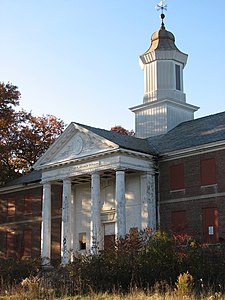McLean Hospital is a psychiatric hospital in Belmont, Massachusetts. It is noted for its clinical staff expertise and neuroscience research and is also known for the large number of famous people who have been treated there. McLean maintains the world's largest neuroscientific and psychiatric research program in a private hospital. It is the largest psychiatric facility of Harvard Medical School, an affiliate of Massachusetts General Hospital, and part of Mass General Brigham, which also includes Brigham and Women's Hospital.

Gaebler Children's Center was a psychiatric institution operated by the Massachusetts Department of Mental Health for severely mentally ill children and adolescents, located in Waltham, Massachusetts.

The Walter E. Fernald State School, later the Walter E. Fernald Developmental Center, was the Western hemisphere's oldest publicly funded institution serving people with developmental disabilities. Originally a Victorian sanatorium, it became a "poster child" for the American eugenics movement during the 1920s. It later was the scene of medical experiments in the 20th century. Investigations into this research led to new regulations regarding human research in children.

Tewksbury Hospital is a National Register of Historic Places-listed site located on an 800+ acre campus in Tewksbury, Massachusetts. The centerpiece of the hospital campus is the 1894 Richard Morris Building.

The Danvers State Hospital, also known as the State Lunatic Hospital at Danvers, The Danvers Lunatic Asylum, and The Danvers State Insane Asylum, was a psychiatric hospital located in Danvers, Massachusetts. It was built in 1874, and opened in 1878, under the supervision of prominent Boston architect Nathaniel Jeremiah Bradlee, on an isolated site in rural Massachusetts. It was a multi-acre, self-contained psychiatric hospital designed and built according to the Kirkbride Plan.

Taunton State Hospital is a psychiatric hospital located on Hodges Avenue in Taunton, Massachusetts. Established in 1854, it was originally known as the State Lunatic Hospital at Taunton. It was the second state asylum in Massachusetts. Most of the original part of the facility was built in a unique and rare neo-classical style designed by architects Boyden & Ball. It is also a Kirkbride Plan hospital and is located on a large 154-acre (62 ha) farm along the Mill River.

This is a list of properties and districts in Massachusetts listed on the National Register of Historic Places. There are over 4,300 listings in the state, representing about 5% of all NRHP listings nationwide and the second-most of any U.S. state, behind only New York. Listings appear in all 14 Massachusetts counties.

Georgia's state mental asylum located in Milledgeville, Georgia, now known as the Central State Hospital (CSH), has been the state's largest facility for treatment of mental illness and developmental disabilities. In continuous operation since accepting its first patient in December 1842, the hospital was founded as the Georgia State Lunatic, Idiot, and Epileptic Asylum, and was also known as the Georgia State Sanitarium and Milledgeville State Hospital during its long history. By the 1960s the facility had grown into the largest mental hospital in the world. Its landmark Powell Building and the vast, abandoned 1929 Jones Building stand among some 200 buildings on two thousand acres that once housed nearly 12,000 patients.

Harrisburg State Hospital, formerly known from 1851 to 1937 as Pennsylvania State Lunatic Hospital, in Harrisburg, Pennsylvania, was Pennsylvania's first public facility to house the mentally ill and disabled. Its campus is located on Cameron and Maclay Streets, and operated as a mental hospital until 2006.

The Trans-Allegheny Lunatic Asylum, subsequently the Weston State Hospital, was a Kirkbride psychiatric hospital that was operated from 1864 until 1994 by the government of the U.S. state of West Virginia, in the city of Weston. Weston State Hospital got its name in 1913 which was used while patients occupied it, but was changed back to its originally commissioned, unused name, the Trans-Allegheny Lunatic Asylum, after being reopened as a tourist attraction.

Western State Hospital, called Western State Lunatic Asylum in its early years, is a hospital for the mentally ill in Staunton, Virginia, which admitted its first patient on July 24, 1828.

The Dimock Community Health Center Complex is a historic medical complex at 41 and 55 Dimock Street in Boston, Massachusetts.

Westborough State Hospital, originally "Westborough Insane Hospital", was a historic hospital in Westborough, Massachusetts, which sat on more than 600 acres (240 ha). The core campus area was located between Lyman Street and Chauncy Lake, north of Massachusetts Route 9. The hospital was added to the National Register of Historic Places in 1994.
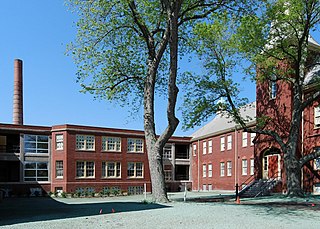
Foxborough State Hospital, historically known as the Massachusetts Hospital for Dipsomaniacs and Inebriates, is a historic medical treatment facility at the junction of Chestnut and Main Streets in Foxborough, Massachusetts. The creation of an alcohol abuse treatment facility was authorized by state legislation in 1889, and the Foxborough campus was developed in the 1890s. The original campus consisted of a series of residential wards in an L shape, with an administration building at the center, and a variety of ancillary support buildings on the grounds. Problems with the facility, including its location, prompted the state to move the substance abuse facility in 1914 to a new campus in Norfolk. The Foxborough campus was then adapted for use as a standard mental hospital. The surviving 19th-century elements of the campus were listed on the National Register of Historic Places in 1994.
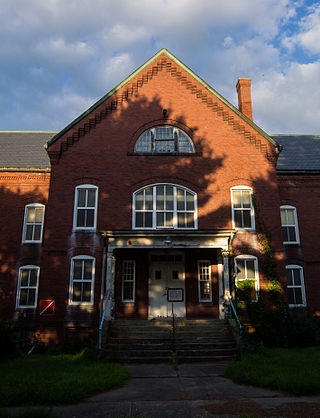
Medfield State Hospital, originally the Medfield Insane Asylum, is a historic former psychiatric hospital complex at 45 Hospital Road in Medfield, Massachusetts, United States. The asylum was established in 1892 as the state's first facility for dealing with chronic mental patients. The college-like campus was designed by William Pitt Wentworth and developed between 1896 and 1914. After an era dominated by asylums built using the Kirkbride Plan, Medfield Insane Asylum was the first asylum built using the new Cottage Plan layout, where instead of holding patients in cells, they would be integrated into a small community and work a specific job. It was formally renamed "Medfield State Hospital" in 1914.
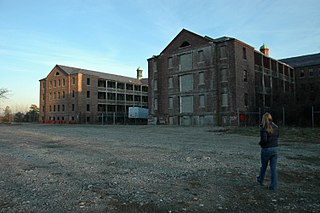
Northampton State Hospital was a historic psychiatric hospital at 1 Prince Street on top of Hospital Hill outside of Northampton, Massachusetts. The hospital building was constructed in 1856. It operated until 1993, and the building was added to the National Register of Historic Places in 1994.

Newton-Wellesley Hospital (NWH) is a community teaching medical center located in Newton, Massachusetts on Washington Street. It is affiliated with Tufts University School of Medicine and Harvard Medical School. Founded in 1881, part of its campus is listed on the National Register of Historic Places as the Newton Cottage Hospital Historic District.
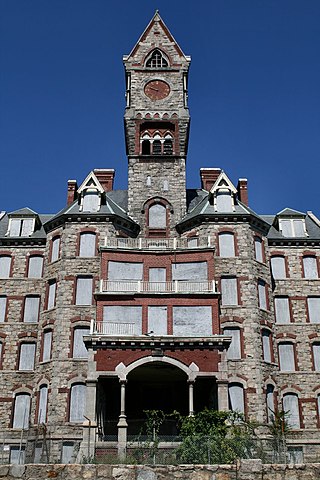
Worcester State Hospital was a Massachusetts state mental hospital located in Worcester, Massachusetts. It is credited to the architectural firm of Weston & Rand. The hospital and surrounding associated historic structures are listed as Worcester Asylum and related buildings on the National Register of Historic Places.

The Templeton Developmental Center was a state-run facility for mentally disabled people located in Templeton, in the U.S. state of Massachusetts. Founded as the Templeton Farm Colony in 1899 through the efforts of Walter E. Fernald, superintendent of what is now called the Fernald School in Waltham, Massachusetts, it was considered an innovative and progressive facility for managing the state's developmentally disabled population at the time. The large facility was closed in 2015, with some intermediate care facilities remaining open on the campus. The property and some of the buildings were listed on the National Register of Historic Places in 1994.

The Maine Insane Hospital, later the Augusta Mental Health Institute (AMHI), was a psychiatric hospital in Augusta, Maine. It was the principal facility for the care and treatment of Maine's mentally ill from 1840 to 2004, and its surviving buildings represent the oldest surviving complex of mental care facilities in the United States. The complex is located on the east bank of the Kennebec River, immediately south of the former Kennebec Arsenal, and now primarily houses state offices. The hospital was replaced by the Riverview Psychiatric Center in 2004, located just to the south. The hospital's core complex was listed on the National Register of Historic Places in 1982, with the listing enlarged to encompass the entire campus in 2001.
